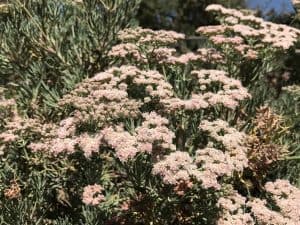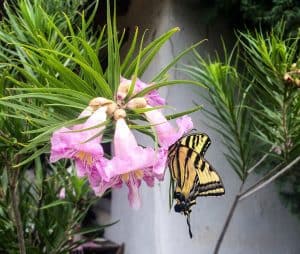July and August are months that tend to merge into one fantastic period when native plants prove their worth and show their strength in times of adversity. When most plants (even the shallow rooted wimpy succulents) that people think are drought tolerant show signs of sunburn, heat stress, wilt, and even death, California natives tough it out because they are perfectly adapted to the conditions of their home. The key is to know their capabilities and provide conditions for them to thrive (much more than survive) through this time of long days, bright light, hot weather, low humidity, and warm soil temperatures (at the surface). Read on.
History/review, current affairs
Be sure to refer to May and June in the Natural Garden 2018. With the scant winter rains of the 2017/18 season (under 6” total in southern California), we discussed supplemental waterings to charge the soil with deep moisture before the heat hits. If your soil is still dry at the ideal depth for healthy roots (12-20”), you have some catching up to do, and in farming or horticulture, you want to not have to play catch up… we should always be farming ahead.
Watering
Look for ideal times to apply water: cool spells, cool mornings with marine layer present, cool evenings with a breeze, cool days. Stay cool. Never water in the heat of the day. Try to soak your ground thoroughly ahead of any heat waves. Watch the forecasts, apply water when it is not blazing hot.
It bears repeating every month in summer… one deep soak every 3-4 weeks May through October, light refreshing sprinkles in between. “Deep soak” means you run the sprinkler or hose end sprinkler about 30 minutes a day, three days in a row (total 90 minutes) in early mornings to thoroughly soak all the ground applying approx. 1.5” precipitation. “Refreshing sprinkle” in late afternoon or early evening means run the sprinkler 3-5 minutes, about 2-3 times a week… enough to wet and cool the leaves and cool the soil surface at the end of the day. Deep soak is an irrigation event. Refreshing sprinkle is not. For more detail see https://californianativeplants.com/wateringnativeplants/
Related to Watering

Let’s look at wilt and what might be causing it. 1) New growth on branch tips that wilts during the hottest part of the day when sun hits it, then recovers by evening. This is called “midday depression,” (I love that term!) and is remedied by trimming the tender new growth off or waiting until the sun’s pattern changes. If the soil is not dry, do not water to remedy midday depression. This is the plant’s response to transpiration happening faster than it can possibly transport water to the new growth. More water in the soil will not help. 2) Crispy wilt, new growth and more, dry dessicated look. This is a sign of real drought stress and occurs because there is not enough water in the pore spaces between soil particles. Time to give your plant a deep soak. 3) Overall wilt, entire branch or entire plant, not so much crispy, more like tired and off color. This happens when there is not enough air (roots need oxygen too) in the pore space between soil particles. Dig a small hole 4-6” deep in the area of the plant’s roots. If the soil is moist, and you are seeing wilt, the plant may have a root rot fungus attacking its feeder roots. They die, and this cuts off water transport, making the plant look like it is dry and needs water. See: Troubleshooting – Varmints, Pests and Diseases below.
Pruning
Only remove old, unsightly seed heads or dead branches. Every branch and leaf that is shading the soil on the surface of the root zone is doing an important job. Very little pruning is needed in summer, only light grooming to make plants look presentable.
Weeding
If you have a lush crop of lush weeds (i.e.milk thistle) in July, you are probably over-watering. The top three inches of soil should not be consistently moist enough to support lush weeds. Old grizzly weeds you might have missed last month can still be cut with a hoe. Tenacious perennial weeds like nutsedge and bermudagrass (both warm season growers) are almost impossible to control without using a contact systemic herbicide. If you do spray, be very careful of volatilization, wind drift, and over-spray especially in hot weather. Attempt to pull or cut weeds. Discard them so the seeds will not stay behind.
Mulching/Top dress
If any, your top dress mulch should already be in place. We do not recommend bringing in fresh organic mulch during hot weather. If open ground is getting hot and baked, apply 2-3” coarse mulch, but keep it away from the trunks, stems and leaves of your plants, as the hot wet organic environment can cause fungi to attack the healthy tissue of your plants.
Feeding
None at this time. You can occasionally liquid feed potted plants. Wait until fall to apply fertilizer to natives in the ground. Desert plants which grow during the warm season can be fed now, according to their needs. Organic fertilizers or liquid feed, half strength will do a nice job.
Troubleshooting – Varmints, Pests and Diseases
Varmints and pests: See July in the Natural Garden 2017, as space is limited here.
Diseases: From Related to Watering above – Summertime wilt of an entire single branch, a portion of the plant, or the entire plant almost always points to root rot. It could be that a gopher has decimated a big part of the root system, but if you see no signs of those little devils, suspect root rot. Native plant roots stay healthy in consistently cool moist soil, 12-18” deep where roots can find water and oxygen. Closer to the surface, soil temps get quite high in summer. If the soil in the top 4-6” is kept consistently wet, roots will grow there, and when summer comes, the high soil temps in that top layer will provide the perfect environment for root rot. This is why you want to water deeply and infrequently, so those roots will explore soil that does not heat up in summer. This is why you want to allow the top 4-6” of soil to dry out between waterings.
On wilt: coffeeberry, island ironwood, ceanothus, sages, will look limp and tired when they have root rot. Manzanita are different. When the leaves lose their sheen, or have brown spots or brown margins (edges), when a branch or the whole plant looks dull and gray, even with no wilt apparent, suspect root rot. Remedies: many or none. Aeration, adjusting watering schedule, applying fungicides, pruning, etc. Please write me at gardenhelp@californianativeplants.com and we’ll work through your specific situation.
See see our Watering Guide to keep your soil cool, and try to maintain a consistent mix of moisture and air at a depth of 8-20”.
Annual Wildflowers
If your spring flowers have made seed heads, mash them up, stomp them, twist them into little bits and unless it would be too unsightly, you can leave this old dead organic matter and seed on the ground where it falls. Natural mulch. Seed will germinate this fall. Or carefully collect the seed for sowing in November.
Adding New Plants

As a general rule wait until October. Desert plants can be handled now.
Engage
In hot weather, the early mornings, late evenings, and even night times are incredible times to be in the garden. Just like every creature that endures summer outdoors, shade will be your best friend. But for a real treat, go out in the heat of the day, stand in the sun and observe the pollinators on your dudleya, buckwheat, and sage, or the lizard on your rock, the hawks circling overhead, and the seemingly delicate butterflies chasing one another. This will help you to know just how tough your plants really are. And wear a hat.
From the Garden,
Mike Evans
Questions? Help is just one call or one email away. Call (949) 728-0685 or email (with pictures if you like) our brand new help email: gardenhelp@californianativeplants.com